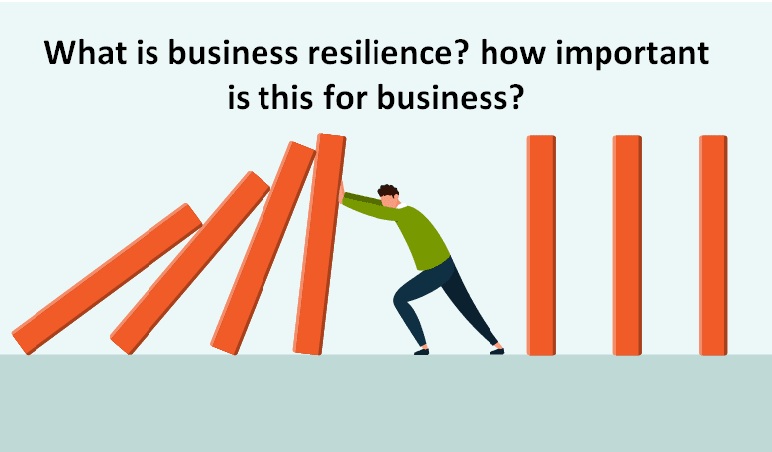What is business resilience?
Business resilience refers to an organisation’s ability to adapt to disruptions while maintaining continuous business operations and safeguarding people, assets, and overall brand equity.
Business resilience involves anticipating potential threats and having processes ready to handle unexpected events. This goal is to ensure the business can still thrive despite challenges. That said, company resilience encompasses not just recovery strategies, but proactive measures to prevent crises and minimise their impact.
Why Is Business Resilience Important?
Running a business comes with its set of risks. From cyber-attacks to natural disasters, disruptions are often inevitable and can lead to significant financial losses or reputational damage if not managed proactively. A company’s ability to handle these facts are what makes or breaks its business operations.
Business resilience is then not just about your ability to maintain operations but also about performing at your desired level despite circumstances, or at least within your acceptable predefined levels before the crisis.
For example, a sudden disruption might force your organisation to change some processes due to limited access to supply and raw materials. But the real challenge lies in ensuring that you can still meet customers’ expectations when it comes to product quality.
Types Of Business Resilience
Below are the different types of business resilience
1)Cyber resilience
Cyber resilience, also known as data resilience, refers to improving technology infrastructure designed to detect, prevent, respond to, and recover from cyber attacks or incidents. Nowadays, the risk of cyber threats is high. In fact,many businesses reported that they had been the target of breaches or attacks in 2023. This underscores how crucial it is to implement a robust the cybersecurity plan and protocol.
2)Supply chain resilience
Supply chain management is critical to maintaining business operations for most organisations. Your ability to support supply chain resilience avoids disruptions limiting your access to raw materials and services vital to your business processes.
3)Reputational resilience
Reputational resilience demonstrates a company’s ability to recover from situations or events that could lead to reputational damage. These companies achieve that through a well-thought-out branding strategy and the contact that enable them to maintain a positive company image. They also achieve reputational resilience through Supply chain continuity with customers, maintaining ethical practices, and proactive communication.
4)Operational resilience
This refers to the company’s ability to ensure critical business functions and operations, regardless of external threats and market conditions. It involves robust planning, risk management, and integrated implementation of a business resilience strategy to maintain critical business systems and processes.
5)Financial resilience
Financial resilience refers to an organisation’s ability to withstand various economic challenges, such as a recession, financial loss, and market volatility. A financially resilient company can maintain a healthy cash flow and diversity in its revenue stream as well as reduce debt levels.
How To Build Business Resilience?
Step1-Develop a business continuity plan
Without plan the company will grind to a standstill in disruptive events. Business continuity management systems need to be activated as soon as certain conditions are met. For example, if productivity drops below a certain level or a key supplier goes out of business.
Step2-Expect (and prepare for) the unexpected
There’s precious little time in the day-to-day running of a business to sit down and think, “What would we do if a sinkhole opened up in front of the office?” – right?
Disasters happen, and you don’t want your business to be caught unprepared and to have to operate at a fraction of your usual productivity for weeks because of an accident that you should have been able to identify and prepare for. It’s worth putting a day or two aside for business leaders, management staff, and resilience professionals to work on contingency plans that will help the business operate as usual if the worst should happen.
Step3-Test and exercise
You may wish to test how your business would respond to a few of the most likely disruptions. This can be as simple as organising a work-from-home day for staff when, for example, train strikes or planned engineering works are announced in advance.
While many companies have already experienced WFH or remote work arrangements amid the pandemic, it’s worth remembering how difficult it was to adjust to such arrangements, and, worse, how many companies failed as a result.
Step4-Establish emergency communication channels
Crisis communication is vital to continuity and disaster planning need to establish:
- Which members of the management and/or communication teams need to liaise with each other?
- Which channels that aren’t connected to the organisation’s digital infrastructure can they communicate? If you experience a cyber-attack, company accounts and even devices may be inaccessible.
- Who is responsible for communicating with team members and deploying the continuity plan?
- Who is responsible for contacting emergency services such as the police, cybersecurity experts, software providers, building managers, etc.?
- How can you contact clients and customers if company accounts are inaccessible?
Step5-Opportunity planning
Circumstances that will affect the company’s long-term prospects can be managed to an extent. However, if a core product becomes redundant or there’s a terminal hit to demand, resilience also means being able to identify new growth opportunities.
New opportunities should utilise the organisation’s current strengths and expertise. This will ensure a smoother transition and should mean that most staff can be retained if the company’s direction shifts.
